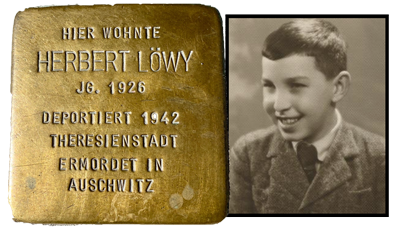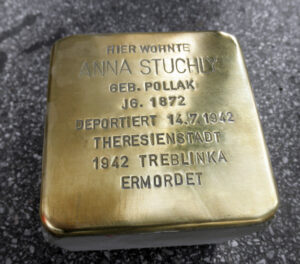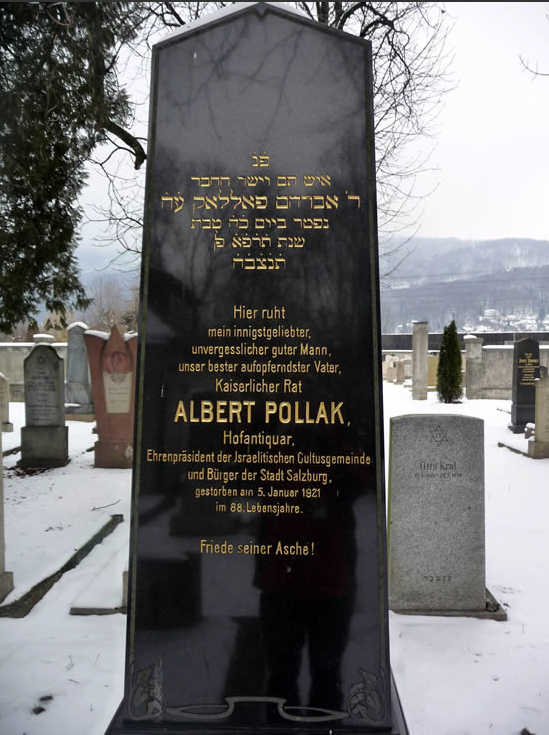Irma HERZ and Anna STUCHLY were two of the daughters of the Jewish couple Karoline Pollak, née Breuer, and Albert Pollak. Irma was born in Salzburg on May 11, 1870 in Salzburg and Anna was born in Salzburg on December 16, 1872.
In 1869 their parents had married in the Lower Austrian city of Wiener Neustadt, Karoline Breuer’s birthplace. At the time Salzburg had neither a Jewish Community Organization nor a synagogue, but the Pollaks had local citizenship rights in Salzburg and all of their Salzburg born children (six daughters and two sons) were registered on the city’s official rolls.
Albert (Abraham) Pollak came from the Jewish Community in Mattersdorf, just across what was then the border between Lower Austria and Hungary [along with most of the westernmost part of Hungary, Mattersdorf opted to join Austria after the dissolution of the Austro-Hungarian Empire in 1919 and since 1924 it has been called Mattersburg].
He had tried to stay in Salzburg after finishing his military service in the Salzburg based Archduke Rainer Regiment, but had been unable to do so because Jews were barred from residing in or even staying overnight in Salzburg. But when the new Austro-Hungarian Constitution went into effect in 1867 the prohibition against Jewish residence was ended and Pollak was able to return to Salzburg and take up residence here – the first Jew to be allowed to do so since the expulsion of 1498.
Albert Pollak began selling used goods, but within a few years he had established a reputation as an antique dealer and was awarded the honorary title of Imperial and Royal Court Antique Dealer along with his local citizenship rights in the city of Salzburg. He was relatively well off and was a homeowner after 1883. The first home he owned was at 12 Schwarzstraße, but he soon sold it to the Jewish couple Nathan and Gisela Kölbl.
At first the Pollak family had lived in the »Überacker Palais« on the Makartplatz. After 1896 they lived in the New Town near the St. Andrä Church in one of the newly built Vienna Ringstraße style »Faber-houses« on what was then called the Westbahnstraße [in the 1930s it was renamed as the Rainerstraße after the local Archduke Rainer Regiment].
In Antisemitic Salzburg the »Faber-houses« and adjacent »Heller-houses« were called the »Jew-houses« because of their Vienna developers and their mostly well off Jewish tenants.
Indeed, many of Salzburg’s Jewish families did prefer to live in the Andrä-Quarter as it was close to both the synagogue and the city center – including the families of Rabbis Wilhelm Pollak and Adolf ALTMANN and cantors Jakob Stefansky and Hermann KOHN.
Thanks to Albert Pollak’s efforts other Jewish families from the Austro-Hungarian border region and other parts of the Empire moved to Salzburg, including those of Albert’s siblings Adolf, Amalia and Katharina.
About 50 Jewish families gained local citizenship rights in Salzburg and Albert Pollak is properly known as the founder of the Salzburg Jewish community – one that set up its own cemetery in 1893, its own synagogue in 1901, and which finally won legal recognition as an independent organization that would maintain its own birth, marriage and death registers in 1911.
Albert Pollak was a member of the religion council and honorary president of the Salzburg Jewish Community Organization. In the peaceful era before WWI he was also awarded the honorary title of »Imperial Councilor« – an honored man who in his old age had to witness the collapse of the Habsburg Empire, the beginnings of the Republic of Austria and the resurgence of aggressive anti-Semitism in Salzburg.
Albert Pollak died at age 87 and found his final resting place in the Salzburg Jewish cemetery. Written on his headstone is:
Here rests my dearly beloved, unforgettable good man, our best self-sacrificing father, Imperial Councilor ALBERT POLLAK, court antique dealer, honorary president of the Jewish Community Organization and citizen of the City of Salzburg, died on January 5, 1921 in his 88th year.
Peace to his ashes!
An inscription that expresses the rise and success, recognition and integration of this family head and representative of the Salzburg Jewish Community – an accurate positioning of its first generation during the long era of peace enjoyed by the Austro-Hungarian monarchy before 1914. The grown children of the Pollak couple had to look elsewhere for a good future.
Karoline Pollak, who survived her husband by 21 years, had 15 grandchildren – not one of whom was born in Salzburg. Karoline’s older son Ignaz Georg became an antique dealer and art critic with a shop on rue Pigalle in Paris since 1910. Starting in 1922 he held a diplomatic passport from the Republic of San Marino and was known as Ignazio Giorgio Pollak.
His first marriage was with the Englishwoman Ruby Underwood and his second was with the Salzburger Roswitha Junger. Between the two marriages he had one son and three daughters. The registration records of the city of Salzburg report that he quit his membership in the Jewish Community and his loss of Austrian citizenship after taking up citizenship elsewhere.
Karoline Pollak’s younger son Theophil was a career officer in the Austro-Hungarian army and then the owner of an agency in Vienna, but he maintained his local citizenship registration in Salzburg.
In 1925 he married a Belgian woman named Germaine van Calster. As he was Jewish and she was Catholic the marriage took place in the City of Vienna municipal offices and not in a synagogue or a church. Their marriage remained childless.
Karoline Pollak’s daughters who married elsewhere automatically took the local citizenship status of their husbands [that was the legally established procedure at the time and even in the US women who married foreigners lost their American citizenship].
Gisela had been the wife of Prague businessman Sigmund Böhm since 1891 and had three children who were born in South Tyrol, Robert, Edith and Ilse. After Gisela Böhm’s early death her children lived with an aunt in Vienna.
In 1902 Karoline Pollak’s youngest daughter Katharina (Käthe) married Abraham Hersch (Hermann) Sporer, an insurance agent and owner of a lottery. The Sporers had four children – Egon, Risa, Hella and Erna – and lived in Vienna, but they spent their summer vacations in Salzburg.
After being widowed in 1921 Karoline Pollak mostly lived with her children in Vienna, reputedly because Salzburg had become too Antisemitic to bear, but she maintained her legal residence in Salzburg at 2 Rainerstraße, first floor. At times her widowed or single daughters Eugenie, Gabriele, Anna and Irma lived there. Karoline Pollak’s daughter Eugenie Brock, whose husband had been a career officer when he was killed in the First Word War, lived alternately in Vienna and Salzburg.
Karoline Pollak’s daughter Gabriele Hirsch, widow of a Berlin manufacturer and mother of two Berlin born children, Regina and Herbert, had to live in Salzburg and Vienna after Hitler took power in 1933. Karoline Pollak’s daughter Anna was married first to Emanuel Fantl and then to Josef Stuchly.
Both marriages, the first with a Jew, the second with a Catholic, remained childless. Anna STUCHLY had abandoned any religious affiliation and lived with her second husband in Salzburg. For a while she managed the business of her late father Albert Pollak, but it didn’t go well. Her second marriage with a man 15 years younger than herself also collapsed.
Karoline Pollak’s oldest daughter Irma married Dr. Leopold HERZ in1888 when he was the regimental doctor of the 4th Dragoon Regiment stationed in Salzburg. Later she moved with him as he served with various other Austro-Hungarian army garrisons.
The Jewish couple had two children, Bela Alexander who was born in Upper Austrian Wels on April 21, 1889, and Therese (Terezie oder Terka) who was born in Prague on March 21, 1899.
Later Dr. HERZ became chief medical officer for the Stanislau garrison in the Crown Land of Galicia which is now in the Ukraine. As eastern Galicia was a hardship post »staff doctor’s wife« Irma HERZ lived in Salzburg with their two children.
Their son Bela Alexander attended the Humanistic Gymnasium [classic academic high school] in Salzburg, but graduated in Vienna before going on to study at the University of Vienna. He got his Doctor of Medicine degree there in December 1912.
He practiced medicine in Vienna until he became an officer and military doctor during the First World War and then director of a nursing home in Lainz (a semi-suburban district of Vienna).
After the dissolution of the Austro-Hungarian Empire, Dr. Leopold and Irma HERZ lived with their daughter Therese in Bratislava (then in Czechoslovakia and now the capital of Slovakia). After the death of Dr. Leopold HERZ his widow moved back to Salzburg with their daughter Therese in May 1929 – both of them had Czechoslovakian citizenship because Dr. HERZ had originally come from part of the Austro-Hungarian Empire that became Czechoslovakia when the Empire was dissolved – and they took up residence in her parents apartment on the first floor of 2 Rainerstraße.
Irma HERZ’s registration card notes that the apartment was provided by her mother Karoline Pollak. The registration records show that under the Nazis a German leader of the Reich Labor Service was quartered in Karoline’s apartment. That eliminated her name from Salzburg.
Irma’s son Dr. Bela Alexander HERZ remained unmarried and converted to Catholicism. He practiced medicine in Vienna and became director of the nursing home in Lainz where his brother-in-law had preceded him.
On March 12, 1938 the 48 year old doctor committed suicide – he was one of many Jews who saw no other way to escape the Antisemitic terror that engulfed Vienna in the days after the Nazis took over the city. Those of his family who were still in Nazi ruled Vienna were able to say goodbye to their loved on in Vienna’s Simmering crematorium.
The survivors also had to say goodbye to each other. As Czechoslovakian citizens Irma HERZ and her daughter Therese were able to leave for still unoccupied Czechoslovakia in September 1938.
Gabriele Hirsch, Katharina Sporer and Theophil Pollak were all able to flee from Vienna in time: they survived in Argentina, Brazil, Belgium and the U.S. Their widowed sister Eugenie Brock died in Nazi Vienna at age 67 on May 3, 1939 and was buried in the Jewish section of the Vienna Central Cemetery.
When her mother Karoline Pollak died in a Jewish home on February 13, 1942 she was buried in the same grave.
The 90 year old lady was thus spared seeing her daughters Anna and Irma and her granddaughter Therese deported.
Anna was the only one of the siblings to take part in the funeral of their mother Karoline as all the others were gone from Vienna. On July 14, 1942 Anna STUCHLY, 70 years old, single, and without any religious affiliation, was deported from Vienna to the Theresienstadt concentration camp – along with the ANINGER, FISCHER and SPIEGEL couples who had been expelled earlier from Salzburg’s Andrä-Quarter.
And on September 21, 1942 – along with Amalie ROSENFELD and Anna POLLAK (Anna STUCHLY’s cousin) who had also been expelled from Salzburg – she was shipped off to the Treblinka death camp, where she was murdered on an unknown date.
Anna’s sister Irma HERZ and her daughter Therese had lived safely in free Prague since September 1938, but in March 1939 it was occupied by the Nazis and became the capital of the German ruled »Protectorate of Bohemia and Moravia«.
The last Prague address of the two Jewish women was 23 Baumgartenzeile in district XIX. Their deportation to the Theresienstadt concentration camp on July 30, 1942 is documented as is the death there of the 72 year old widow Irma Maria HERZ on November 18, 1942.
The carefully kept records of the Theresienstadt concentration camp include a death report noting that she was Roman Catholic by religion. Irma’s daughter Therese was presumably also a convert from Judaism to Catholicism as she had the very Catholic middle name Maria, just like her mother. In any case we know that the 44 year old Therese HERZ was deported in transport »Ds« from Theresienstadt to the Auschwitz death camp on December 18, 1943.
The approximately 2,500 prisoners in transport »Ds«, including the officers’ widows Helene FRÖHLICH and Klara KIESLER who had also been expelled from, were not gassed on arrival. They were put into the »Theresienstadt family camp«, which contrary to its name was in Sector B II b of Auschwitz-Birkenau.
The SS used this misleading name to cover up their mass murder: gassing its inmates to death after a six month »grace period«. Therese HERZ was lucky enough to be one of the few prisoners who was found fit for work before the liquidation of the »Theresienstadt family camp« in July 1944.
She was sent for forced labor in Hamburg which was being severely damaged by the Allied bombing campaign. In March 1945 the survivors of this labor battalion who had to endure air raids without shelter and who were often killed by unexploded bombs in the rubble were forced to march to the Bergen-Belsen concentration camp.
Therese HERZ survived to experience the liberation of Bergen-Belsen on April 15, 1945 and also survived the epidemic that raged there even after the liberation. On July 24, 1945 she was transferred to a Swedish Displaced Persons camp. But then her trail ends and we don’t know where Therese HERZ went from there.
There is a memorial page for Karoline and Albert Pollak’s daughter Irma HERZ in the Shoah-Databank of Yad Vashem but there is none for Anna STUCHLY. Their younger brother Ignaz (Ignazio) Pollak survived the years of horror in occupied France and died in Nice in 1945.
We also know that Theophil Pollak, who survived in Belgian exile, was the only one of the Pollak children to return to Austria. He died in Vienna at age 77 and his ashes were put in the same grave as those of his nephew Dr. Bela Alexander HERZ (the period for maintaining this grave ran out in 1998).
One of Albert and Karoline Pollak’s grandchildren also returned to Austria from exile: Edith Billiter, née Böhm was the wife of the chemist and inventor Dr. Jean Guillaume Billiter and they bought a villa in St. Gilgen on the Wolfgangsee near Salzburg.
The Billiter’s ashes have been interred in the St. Gilgen cemetery. No grave was ever created in the Salzburg Jewish cemetery for any child or grandchild of Karoline and Albert Pollak.
Sources
- Jewish Community Organizations of Linz, Salzburg and Vienna
- Salzburg and Vienna City and State archives
- Shoah-Databanks of the Documentation Center of the Austrian Resistance [DÖW] and Yad Vashem
- Death records of the Theresienstadt Concentration Camp
Translation: Stan Nadel
Stumbling Stone
Laid 02.07.2014 at Salzburg, Rainerstraße 2 (Ecke Hubert-Sattler-Gasse)





